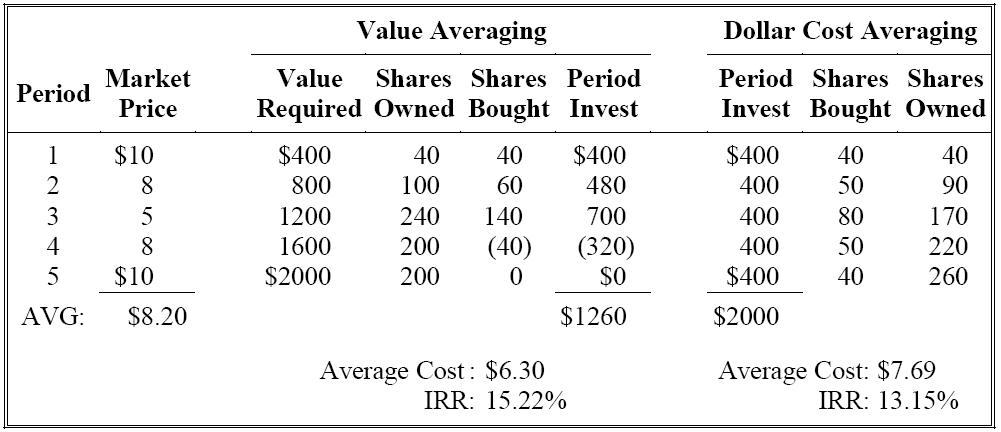WHAT IS VALUE AVERAGING
Value Averaging is a combination of its better-known cousin
- "dollar-cost averaging" - and a process known as
"portfolio rebalancing."
The value averaging method, has been shown to produce better
results over time than the old "dollar-cost averaging"
method. Edeleson has tested VA using simulations to compare
VA to DCA and purchases of a constant number of shares in
each investment period. Without considering possible
differences in risk, Edleson concludes:
-
“There is
an inherent return advantage of value averaging (over
dollar-cost averaging and purchase of a constant number
of shares).”
-
“It’s about
as close to ‘buy low, sell high’ as we’re going to get
without a crystal ball.”
Edleson, who was also a managing director at Morgan Stanley
(MS), relied on one crucial piece of information that was
missing from the "dollar-cost averaging" method to come up
with "value averaging." By considering a portfolio’s
expected rate of return (something that the "dollar-cost
averaging" method neglects), the value averaging method
helps to identify periods of over and underperformance.
When a portfolio is underperforming, share prices are likely
to be low. And that’s when you’ll be investing more to make
up for the underperformance. When the portfolio is
outperforming your target rate return, share prices are
likely to be high. That means it is not a good time to buy
and you could even sell for a profit, provided you maintain
your predetermined average growth rate.
Value Averaging is a nice way to ensure you follow one of
the most well known investment mandates: Buy low and sell
high. The method is particularly valuable during
times of high volatility to help ensure investors
maintain discipline in their investing. And in these
difficult market conditions, it’s certainly worth
considering.
“The rule under value averaging is simple: ... make the
value not (the market price) of your investment go up by a
fixed amount each month.”
HOW VALUE
AVERAGING WORKS
Basically, the idea behind
dollar-cost averaging is that instead of investing a sum of
money all at once, you invest it a little bit at a time over
a specific period. So, for example, if at the beginning of
the year you had $12,000 that you wanted to invest in
stocks, you might invest $1,000 each month over the course
of a year instead of investing it all at once. This is
essentially Dollar Cost Averaging where the idea is that you
reduce risk because you're buying stocks at a variety of
prices throughout the year instead of buying all the shares
at a single price. Dollar cost averaging is a “Buy low, buy
less high” strategy, as there are no rules for selling.
Value Averaging works a bit
differently. With Value Averaging, you first figure out how
much money you will need to accumulate for a goal such as
retirement. Then, based on the annualized return you expect
to earn on your investments, you figure out how much you
must invest each month to achieve that goal.
So let's say you have a goal of
accumulating $500,000 over the next 20 years. If you figure
you can earn an annualized 8 percent, then you would need to
put away about $875 a month. You can then chart your
progress month by month towards that goal. Here's where the
"value" part of value averaging comes in. Let's say that, at
the end of the first year, instead of having the $10,950 you
should have to be on track toward your goal, a downturn in
the markets leaves you with just $10,000.
That would mean that the next
month, instead of investing your usual $875, you would
invest an additional $950 to bring your portfolio's value to
where it should have been to remain on track toward your
goal. In fact, you would go through this process each month.
In months where you fall behind, you would add to the amount
you invest each month. And in months where your returns are
higher than expected and your portfolio's value gets beyond
where it needs to be, you would scale back your monthly
investment, or even possibly end up selling some shares. Hence, value averaging provides sell signals so when properly applied, it should help us to "buy low, sell high".

HOW VALUE AVERAGING DIFFERS AND WHY IT
WORKS
While either approach (VA or DCA) could dominate over any time
period, value averaging has the edge most of the time because it is more
aggressive. However, value averaging requires more monitoring,
has more transaction costs, and because it triggers sales,
potentially more tax consequences. Value averaging can be
modified so that no sales take place, with future value
increases adjusted to compensate. Also, the loss potential is
greater for value averaging because the total amount that is
required to be invested is unconstrained.
At
first glance the VA strategy may not seem too different from DCA,
however there are significant differences:
-
A large upward
price swing often results in the sale of shares, instead of
a purchase.
-
VA also results
in a net average cost per share that is much lower than the
average cost per share with DCA.
-
There is often
a tendency to sell shares when the share price is high; the
best DCA can do is buy fewer of the more expensive shares
-
VA takes a more
extreme response to market dips and rises than does DCA. The
return is enhanced greatly by the larger purchases at low
prices and by the profit taking as shares are sold at
generally higher prices.
-
VA forces you
to avoid big moves into a peaked market or panic selling at
the bottom
-
VA tends to
provide the highest returns in the stock market over short
to immediate term investment periods.
Value Averaging (like DCA) helps investors to
tide over market volatility without worrying too much about
market timing.
|
